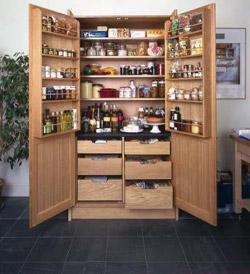 A Well Stocked Pantry
A Well Stocked Pantry
Here are the items in alphabetical order that I try to keep on hand. You'll be pretty sure to always be prepared no matter what you want to whip up.
Baking powder:
A chemical leavener consisting of baking soda and acid. When mixed with a liquid and heated, baking powder produces carbon dioxide gas that makes batter rise. You can use two types of baking powder:
Single-acting baking powder:
Requires only liquid (such as combining dry and wet ingredients) to activate. You should use this baking powder only if baking takes place immediately after mixing the batter. Within half an hour, this baking powder loses its leavening power.
Double-acting baking powder:
Releases gas in two stages and enables batters to stand for a period of time without losing their leavening power immediately. Stagger your baking time. Check the freshness date because baking powder can lose its effectiveness if left on the shelf for a year or more. To test, mix 1 teaspoon baking powder with 1/3- cup (3 ounces) water. If it fizzes, it's good.
Baking soda:
A leavening agent for many baked goods and batters, specially those that contain an acidic ingredient like vinegar or buttermilk. You also can use it in a refrigerator (with lid open) to absorb odors. Change the box every six months.
Brown sugar:
Use brown sugar in recipes that call for a caramelized sugar flavor. Store in a canister with a tight-fitting lid. Brown sugar comes either packed or pour able, sometimes called brownulated.
Butter:
Always have plenty of butter on hand for making pie crust, batters, sauces, and so on. Buy unsalted, or sweet, butter so that you can control the amount of salt in a recipe. Butter has a shelf life of a month or more in the refrigerator; you can store excess butter in the freezer for up to a year.
Chocolate:
Have 8-ounce bars of bittersweet and semi-sweet chocolate on hand for all kinds of recipes, from mousses to cookie batter. Milk chocolate melts at a lower temperature than other chocolates, so store it in a cool place. Chips are good to have around, too, for cookies.
Cinnamon:
A spice frequently used in cookies and puddings. Keep the powdered form in an airtight jar.
Cornstarch:
A thickening agent (100 percent refined starch) sometimes used in place of flour - for example, when making pastry cream or ladyfingers.
Corn syrup:
An all-around sweet syrup, sometimes flavored with vanilla, for batters of all kinds.
Cream (heavy cream or whipping cream):
A cream that generally has a 36 to 40 percent butterfat content, which allows it to whip up into a solid. The high percentage of fat gives it a rich texture and flavor that is desirable in many desserts.
Cream of tartar:
A by-product of winemaking, it's also known as potassium acid tartar. You can use cream of tartar in tandem with baking soda to leaven baked goods. As a stabilizer, you can use it to improve the quality of whipped egg whites - producing smaller air bubbles - and to give meringues fuller body.
Eggs:
Large eggs, as fresh as possible. Most recipes are based on large eggs unless stated. Raw eggs are good for about four weeks beyond their packing date.
Flour (all-purpose):
For all kinds of baking and batters. Store in an airtight glass or plastic container, away from sunlight.
Flour (cake):
The preferred flour for light-textured cakes and other desserts with a light, soft crust. Cake flour is made from wheat with a soft, smooth texture and pure white color. Use cake flour for cakes and doughs because it yields a flakier consistency. Be sure to buy plain cake flour, not the self-rising kind, which already contains added leavening and salt. Store in an airtight glass or plastic container, away from sunlight.
Gelatin:
A colorless, odorless, and sugarless powder (not to be confused with Jell-O, which is the trademarked name for a flavored gelatin-based dessert). You can use gel-atin in cake fillings and to stabilize whipped creams. Gelatin needs to soften in cool water for five minutes before using- it dissolves in water and becomes a thickening agent. Gelatin continues to thicken a mixture over a 24-hour period.
Honey:
For sweetening certain batters and other mixtures.
Jams and preserves:
It's always a good idea to have several fruit jams or preserves on hand for glazing tarts and certain piecrusts. Apricot, orange, plum, and cherry are good choices.
Lemons:
You can use the juice and skin (zest) of lemons all the time in every kind of dessert. Lemons should be firm, not mushy, and the skins should be bright and unblemished.
Milk:
Use whole milk, as fresh as possible, unless skimmed milk is called for.
Nonstick spray:
Pam is the best-known brand. Non-stick vegetable spray works well to prevent batters and other foods from sticking to a pan or baking sheet.
Nutmeg:
Whole nutmeg is far superior to the powdered variety. Scrape whole nutmeg on a grater. Keep it in an air-tight jar. You can use nutmeg to season puddings, pies, and sauces.
Nuts:
Store walnuts, pecans, pistachios, hazelnuts, almonds, and other nuts (whole or peeled) in airtight con-tainers or in the freezer.
Sugar:
Use white granulated sugar as an all-around sweetener. Use confectioners' sugar for fine textures and for whipped cream.
Vanilla bean:
The best vanilla beans are cured by a natural sun-drying process that intensifies their flavor. Most flavor is in the powdery inner seeds - split them length-wise. The flavors imparted are stronger when the bean is infused - allowed to steep (sit in a hot liquid to extract flavor, like a tea bag) - in a hot liquid, such as milk.
Vegetable shortening:
Used primarily for pie dough, to give it a flaky crust. Get solid, white all-vegetable short-ening, like Crisco.
